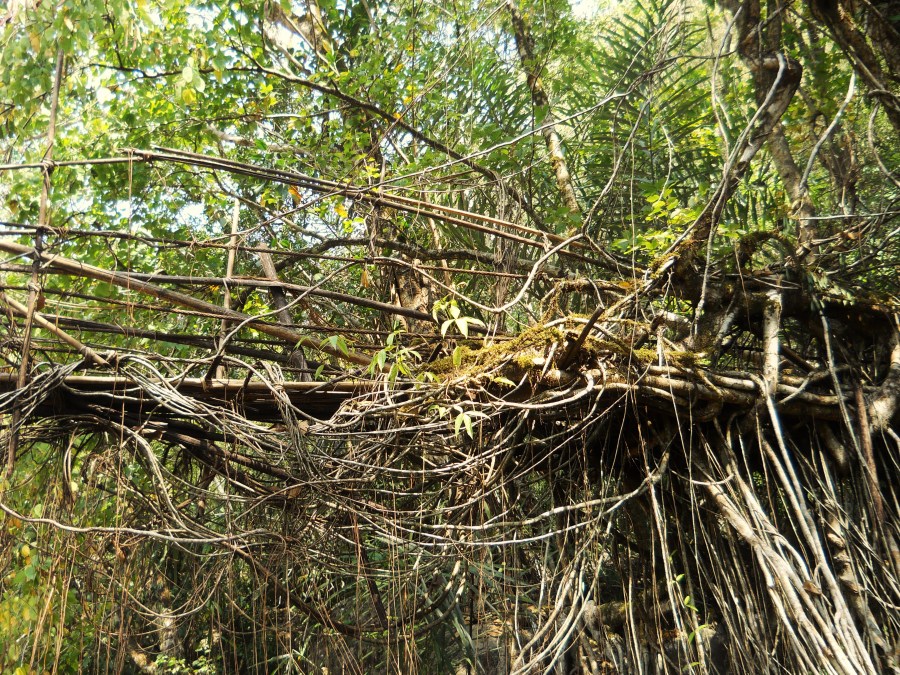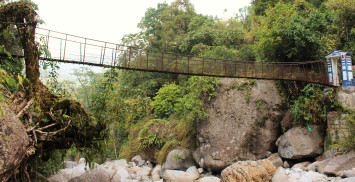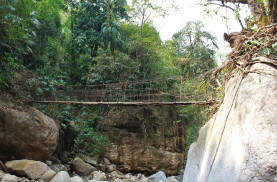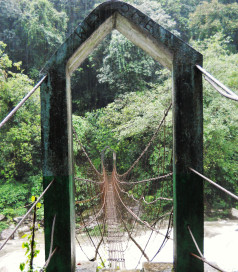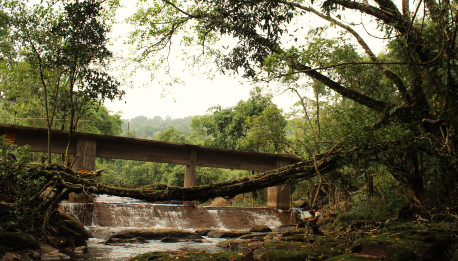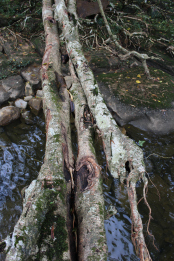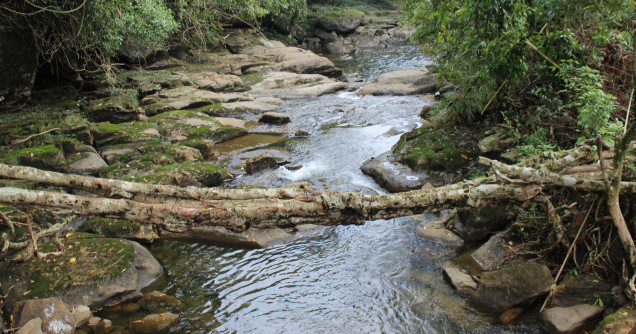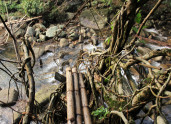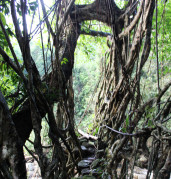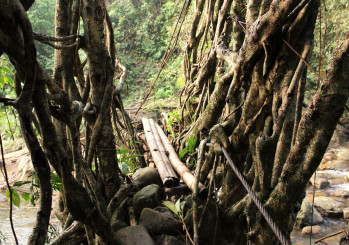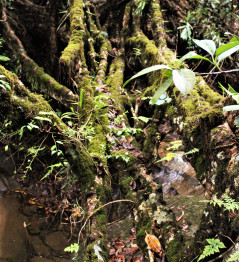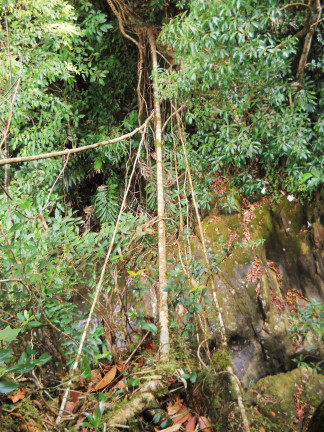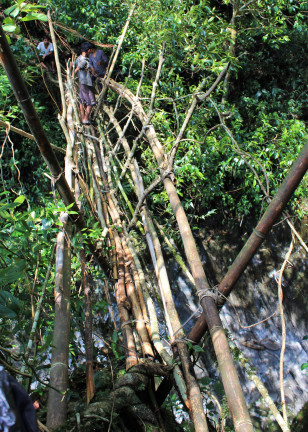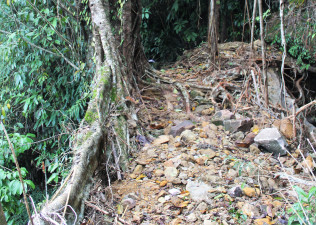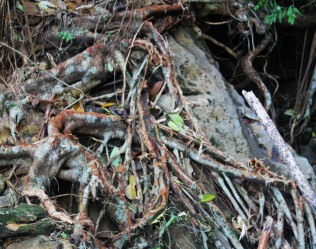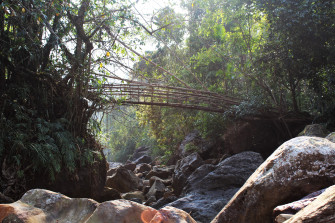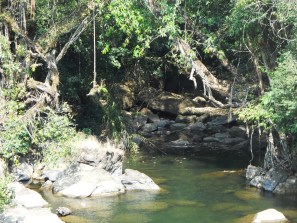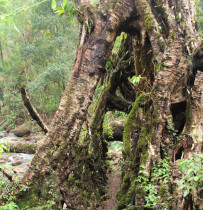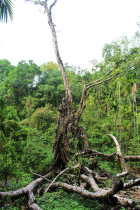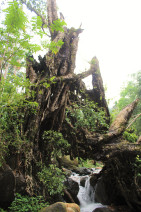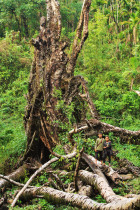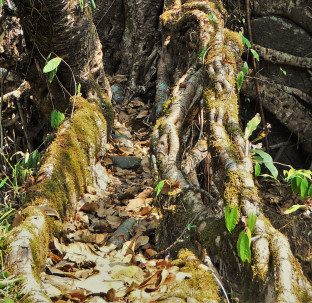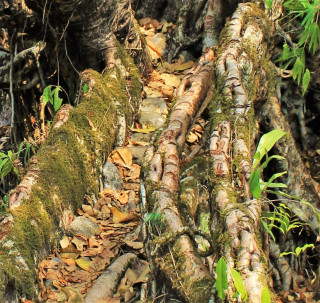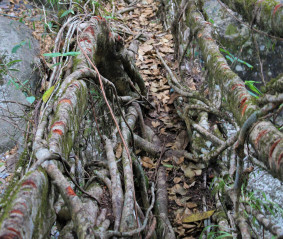
In the foreground are the remnants of a living root bridge which is said to have fallen ten to twenty years ago due to a flood. In the background is a recently built steel-wire bridge which replaced the botanical structure.
For a listing of verified failed living root bridges, please go to: Failed Living Root Bridges
Travelling extensively in Southern Meghalaya, it’s been made very clear to me that the region’s botanical architecture is fading away, so an important part of my project has been to attempt to ascertain why.
At first glance, the claim that botanical architecture would be disappearing seems improbable precisely because of the chief advantage of living structures, which is that they grow and strengthen themselves. Why would self-renewing architecture be fading out?
The answer to this is a complex combination of social and environmental factors which aren’t immediately apparent when travelling to the main tourist areas where botanical architecture occurs. In tourist zones, which only account for a small fraction of the areas where botanical architecture can be found, the locals have an immediate economic incentive for preserving living root bridges, given that the structures have become an attraction. My experience, however, has been that these areas are not representative of the overall state of the practice, and the botanical architecture found in tourist areas is often in much better condition than it is outside of them (this is even factoring in places where littering tourists have degraded the local environment).
This is not to say that the disappearance of botanical architecture is equally well along in non-tourist areas throughout the range of the practice. In certain villages, living root bridges are only a memory, sometimes having disappeared generations ago, while in others botanical architecture is still being used and maintained, even if the structures are gradually being replaced. Also, variables as diverse as local agricultural practices, educational levels, and recent road construction, can all affect the health of living architecture. Hence, the larger picture is complex, and threats to root bridges in one area may not be present in another.
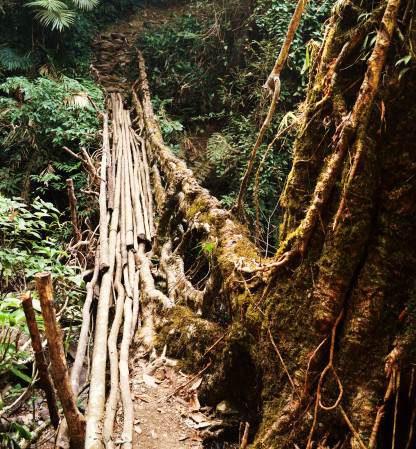
SOCIAL FACTORS FOR THE DISAPPEARANCE OF BOTANICAL ARCHITECTURE
The simplest way of looking at the cause of the disappearance of Meghalaya’s botanical architecture is to examine its primary liability, which is that it takes a very long time to become functional and safe to use. The locals now have other, quicker, options. If a living root bridge fails for any reason, it is simply more convenient to replace it with a conventional, immediately usable, structure, than it is to grow a new living root bridge. This is especially true when the government can provide infrastructure funding. Even if a steel or concrete bridge is more expensive and doesn’t have the environmental benefits and longevity of a living root bridge, it will be usable much sooner. Villagers often simply don’t have the choice of waiting years for a living root bridge to become functional. Additionally, if a living bridge is damaged and becomes a safety hazard, it makes more sense to repair it or replace it with conventional wood, steel, or concrete structures, than it does to wait the years it would take to make the structure functional again using traditional, botanical means.
As will covered in detail below, a host of physical issues (floods, fires, landslides, direct man-made damage) confront botanical architecture, and as these issues become more acute and destroy more bridges, the failed structures are replaced at an increasing rate by conventional structures, and so the practice as a whole fades.
DIRECT REPLACEMENT:
Many living root bridges that fall are replaced by conventional structures which occur at roughly the same place where the root bridge once existed.
Examples of replaced living root bridges

This is the place where the process of the replacement of botanical architecture is perhaps easiest to observe. In the photo to the left are the remnants of a living root bridge on the way to the tourist-frequented village of Nongriat that was abandoned after a flood. The structure once had three sections, but two of those were washed out in a flood. To the right is the steel-wire structure which replaced the botanical bridge.
This is a root bridge which was too severely damaged in a flood to remain functional, though it was still standing as of the Spring of 2016. Behind the remnants of the botanical structure, you can see a replacement concrete bridge that is still under construction.
This is an example of a fallen root bridge where an attempt was made to replace it with a conventional structure, while still incorporating the significant remnants of the original botanical bridge. After the original root bridge fell (which I am told occurred around 20 years ago), the structure went through both steel and bamboo iterations. Note that the steel cables have been worked into the ficus elastica tree. Still, floods have made maintaining a bridge at this position impossible.
BYPASSED AND ABANDONED BRIDGES:
While many living root bridges are directly replaced by other structures, some are bypassed, meaning that the trails they once serviced are not used anymore, or are used less frequently. Often, this happens when a road has been built in the near vicinity. Once a root bridge is no longer in common usage, the community interest in its upkeep fades, and the bridge frequently falls into disrepair and disuse.
These are pictures of a bridge that has not been in use for over ten years. The path it once serviced has faded out, having been bypassed by a road. The bridge has been damaged both by floods and by people taking hacks out of it with machetes.
LACK OF NEWLY CREATED LIVING ROOT BRIDGES
Over the course of the Living Root Bridge Project, I’ve encountered evidence of numerous living root bridges that have fallen and have been replaced with conventional structures. However, in what is arguably the most important indicator that the practice of creating botanical architecture is fading, I’ve found very little evidence of new bridges being grown, other than for tourism purposes.
Again, it is important to stress the difference in the state of affairs pertaining to botanical architecture inside and outside of tourist areas. In the village perhaps most closely associated with living root bridges, Nongriat, and its next-door neighbor, Nongthymmai, a great deal of time and effort has been allocated towards generating new living root bridges, along with very actively maintaining already existing botanical structures.
These are pictures of the same living root bridge. The picture to the left is from February 2015. The photo to the right is from April, 2016. This is the only living root bridge I’ve come across which has been generated recently, and outside of a tourism zone. However, most of the additions made to the bridge, visible in the photo to the right, were made by a local eco-tourism/heritage society (members of which are pictured), which is trying to ensure that the structure develops properly.
There is ample evidence that root bridges are failing rapidly, and that the number of new ones being created, even if one factors in newly generated root bridges in tourist areas, do not even approach making up for the loses.
ENVIRONMENTAL FACTORS FOR THE DISAPPEARANCE OF BOTANICAL ARCHITECTURE
This section deals with the physical rather than social causes of root bridge failure. These may be grouped into two categories: Failures resulting from direct man-made damage being inflicted on the structures, and failures resulting from the overall degradation of the environment surrounding the bridges.
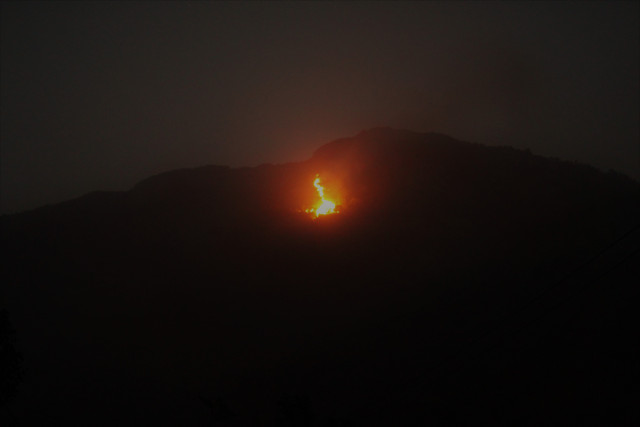
FLOODS AND LANDSLIDES
While root bridges can be subjected to a variety of threats, what tends to finally cause them to fail are floods and landslides. Southern Meghalaya is famous for receiving more rain than any other inhabited spot on the globe. This precipitation mostly falls between April and October, with the heaviest rainfall usually coming in June or July. Due to the steep terrain, during periods of severe precipitation many of the area’s rivers are essentially in a state of non-stop flash flooding, during which the living root bridges which cross them are continually subjected to extremely intense conditions, both from the pressure of the floodwaters, and from debris carried down the stream beds.
Additionally, villagers are often of the opinion that the landslides associated with floods have gotten worse in the past few decades. This is most commonly blamed on two factors: road construction, and shifting cultivation fires which have destabilized slopes by reducing jungle cover. By stripping away the vegetation on a hillside, the slope becomes less able to absorb rain-runoff, often resulting in landslides.
This is a living root bridge which was severely damaged by a landslide caused by road construction. The photo to the left shows the root bridge covered in debris. The picture to the right shows specific damage caused to the organism by the landslide. The landslide was triggered after heavy rain dislodged material from a hillside which had been destabilized by road building.

DIRECT FIRE DAMAGE
In some instances, fires burn living root bridges directly. This can either happen as a result of accidents with cooking fires or cigarettes, or as an unintended consequence of slash-and-burn cultivation fires.
It’s worth noting that the latex material found within the ficus elastica organism is flammable. In the opinion of locals I’ve talked to, while it’s quite hard to get a root bridge to catch fire, once it does begin to burn, the fire is nearly impossible to put out.
These are two places where living root bridges once stood, though they were destroyed by accidental fires.
These are pictures of a living root bridge that was accidentally damaged by a slash-and-burn fire in 2015. The bridge was still standing as of Spring 2016, though it is unlikely to survive much longer.
LATEX EXTRACTION CUTTING

By far the most ubiquitous form of direct damage to living root bridges are cuts made into the surface of the ficus elastica plants in order to extract the latex found inside the organism. After an incision is made, the latex is allowed to bleed out of the plant for a few days. Then the substance is harvested, processed, and either used in animal traps, or sold. In my experience, the vast majority of living root bridges have some kind of latex extraction damage. The scars made in the structures are permanent, which means that, even in the case of root bridges in tourist areas where latex extraction cutting has been banned, old damage is often still present.

The amount of harm done to the trees and to the bridges varies from example to example. In some instances, the cuts are very minor and probably will only cause limited damage to the organism. However, in some instances the cuts have covered much of the surface of the bridge and the tree it is formed from, significantly harming the health of the plant, while also weakening the structural integrity of the living root bridge. In instances where a living root bridge is no longer in use, the damage is often extreme, given that the structure serves no other functional purpose and so is not protected by its community.
The slide show below is meant to give some impression of how widespread the problem of latex cutting is. Each of the nineteen photos below are from a different living root bridge.
While travelling in the Khasi Hills, I have been able to visit many living root bridges more than once, and so have been able to compare them over time. I have come across several examples of living root bridges where the damage had increased greatly over the space of only a year.
These are pictures of a living root bridge I visited both in 2015 (left photo) and 2016 (right photo), showing roughly the same portion of the structure. While the bridge was already damaged in 2015, the amount of damage had increased significantly as of 2016. A direct comparison of the photo to the left with the one to the right shows a large number of fresh latex extraction wounds on the tree. This bridge only sees limited usage as the stream it crossed changed course due to a landslide and now only floods during the worst part of the monsoon season. Local villagers have no direct incentive for the bridge’s upkeep.
Above is a slide show of damage done to a large feature of a living root bridge that I visited in 2015 and 2016.
This is the same view of a section of a living root bridge. The photo on the left was taken in 2015, and the the photo on the right in 2016. The photo taken a year later shows significant and very recent damage to the railings.
While latex extraction cutting is perhaps the most widespread direct threat botanical architecture faces, it is also one of the most easily addressed: village councils can simply ban the practice. This has successfully be done in tourist areas such as Nongriat, and also in the village of Laitiam.
CONCLUSION
Sadly, the living root bridges are fading. The vast majority of them may have disappeared well before any attempt will have been made to study them scientifically or even document them. The Living Root Bridge Project is therefore concerned with presenting hard proof that there are immediate threats to the practice of living root architecture, which, if they are not dealt with soon, will constitute an immense loss for the people of Meghalya, those of India, and for world heritage in general.
Above I’ve only given a brief overview of the threats faced by botanical architecture in Meghalaya. Other, wider, societal issues such as access to education or economic factors can contribute indirectly to the fading the practice. Likewise, while tourism has resuscitated the practice in certain pockets, and is the only reason why there is any knowledge of botanical architecture beyond southern Meghalaya, tourist zones can lead to root bridges being directly damaged by unscrupulous tourists, and can cause misleading information to be disseminated. False information, such as the notion that root bridges only occur in one specific area, that there is a definite, known, number of living root bridges, that certain villages “invented” them, or that botanical architecture is not threatened, ultimately degrades the practice as whole because it leads to faulty assumptions, and so obfuscates any attempt to get a clear picture of what needs to be done to conserve botanical architecture.
